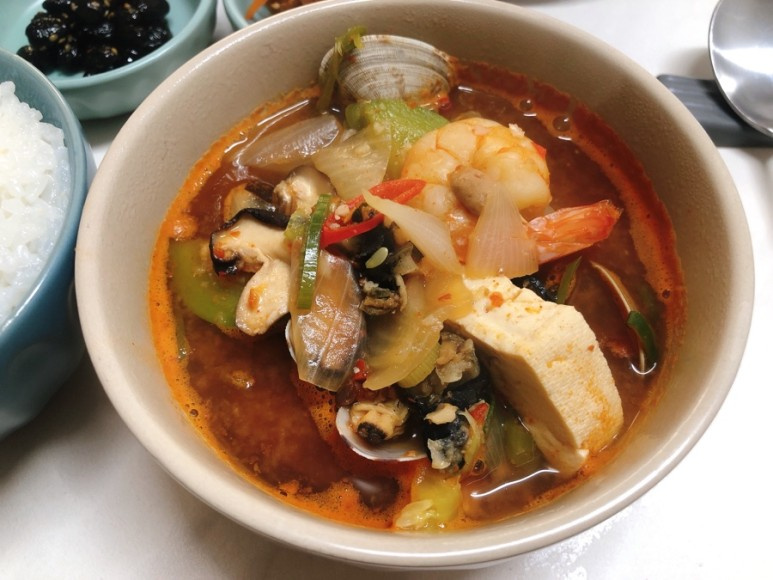Hearty and Refreshing Seafood Doenjang Jjigae
Quick and Spicy Seafood Doenjang Jjigae Recipe with Leftover Seafood

This seafood doenjang jjigae is incredibly flavorful and satisfying, requiring only a few key seafood ingredients! You can use whatever seafood you have on hand. My husband wanted some today, so I whipped up this quick and delicious version!
Main Ingredients- 6 clams (purged)
- 2 cocktail shrimp (thawed)
- 1 Tbsp periwinkles (rinsed)
- 1/3 Korean zucchini (hobak)
- 1-2 shiitake mushrooms
- 1 cheongyang pepper
- 1/2 green onion stalk
- 1/2 onion
- 1/3 block firm tofu
Seasoning- 1 Tbsp doenjang (Korean soybean paste)
- 0.5 Tbsp gochujang (Korean chili paste)
- 1 Tbsp soup soy sauce (guk-ganjang)
- 1 Tbsp gochugaru (Korean chili powder)
- 1 Tbsp minced garlic
- 0.5 Tbsp sugar
- 0.3 Tbsp Dasida (MSG-based soup stock) or fish sauce
Broth- 800ml rice water
- 1 Tbsp doenjang (Korean soybean paste)
- 0.5 Tbsp gochujang (Korean chili paste)
- 1 Tbsp soup soy sauce (guk-ganjang)
- 1 Tbsp gochugaru (Korean chili powder)
- 1 Tbsp minced garlic
- 0.5 Tbsp sugar
- 0.3 Tbsp Dasida (MSG-based soup stock) or fish sauce
Broth- 800ml rice water
Cooking Instructions
Step 1
Prepare your seafood. I didn’t need to do much since my clams were already purged and frozen, and my periwinkles were washed and frozen. I used thawed frozen cocktail shrimp. Fresh seafood will yield the best flavor, but frozen is perfectly fine too.

Step 2
Slice the half onion into bite-sized pieces, about 1 to 1.5 cm thick. The onion will add a subtle sweetness and depth of flavor to the broth.

Step 3
Slice the Korean zucchini (hobak) into half-moons or about 1 cm thick rounds. It adds a pleasant softness and refreshing taste to the jjigae.

Step 4
If using dried shiitake mushrooms, soak them in lukewarm water for about 15-20 minutes until rehydrated. Trim the tough stems and slice the caps. Fresh shiitake mushrooms can be sliced directly.

Step 5
Slice the cheongyang pepper diagonally for a bit of heat. If you have a red chili pepper, slicing it too will add a nice visual appeal.

Step 6
Dice the tofu into roughly 1.5 to 2 cm cubes. Adding tofu towards the end helps it keep its shape. Don’t worry if you’re missing an ingredient; feel free to substitute or omit it based on what you have available. This is your chance to create a personalized recipe!

Step 7
Save the cloudy water from when you rinse your rice to use as the broth for your doenjang jjigae. Rice water helps to mellow out the flavor of the doenjang and absorb seasonings well. You’ll need about 800ml.

Step 8
Pour the 800ml of rice water into a pot. Add 1 tablespoon of doenjang and stir to dissolve. It’s helpful to put the doenjang through a sieve into the water to ensure it dissolves smoothly without clumps.

Step 9
To prevent the jjigae from tasting too one-dimensional, add 0.5 tablespoon of gochujang. It enhances the savory notes of the doenjang and adds a pleasant spiciness.

Step 10
Once the broth comes to a rolling boil, add the prepared seafood (clams, shrimp, periwinkles) and let it simmer for a few minutes.

Step 11
As the seafood cooks, skim off any foam or impurities that rise to the surface. This step is crucial for a clear, clean-tasting broth.

Step 12
After skimming, add the sliced onion, zucchini, and rehydrated shiitake mushrooms to the pot. Let them simmer and cook through, releasing their natural sweetness and umami into the broth.

Step 13
Add 1 tablespoon of minced garlic. Garlic is essential for building the aromatic base and boosting the overall flavor of the jjigae.

Step 14
Stir in 1 tablespoon of gochugaru (Korean chili powder) for a vibrant color and gentle heat. Adjust the amount to your spice preference.

Step 15
For a balanced flavor profile, add 0.5 tablespoon of sugar and 0.3 tablespoon of Dasida (or fish sauce) for extra umami. The sugar rounds out the flavors, while Dasida adds depth.

Step 16
Finally, add 1 tablespoon of soup soy sauce (guk-ganjang) to adjust the overall seasoning. While guk-ganjang adds a rich flavor, be mindful not to add too much as it can make the jjigae too salty.

Step 17
When the jjigae is bubbling vigorously and the vegetables are tender, add the sliced cheongyang pepper and green onion. Simmer for another minute. Before turning off the heat, taste and adjust the seasoning if needed with a pinch or two of salt. Enjoy your delicious homemade jjigae!



